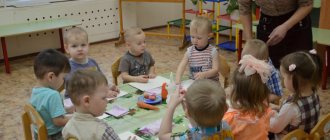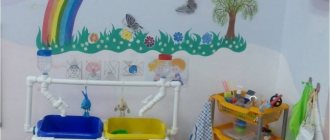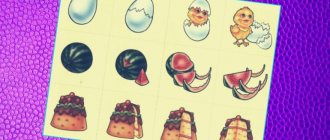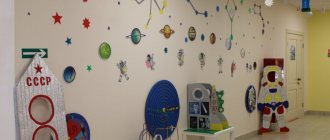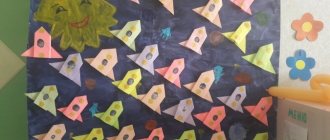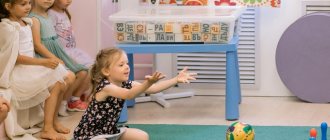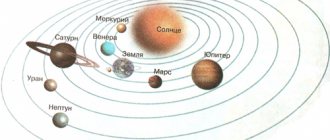Senior group. Senior preschool age. Children 5-6 years old
Game for older preschoolers “Finest hour. Space" Game for older preschoolers "Starry Hour"
Several participants play. They are given cards with numbers from 1 to 5. For each question, 5 answer options are given, participants must choose the correct one. For each correct answer, participants receive a star. The winner is the one who gets...
Didactic game “Space travel with Belka and Strelka” for children of senior preschool age
Didactic game “ Space travel with Belka and Strelka”
for children of senior preschool age Game material: a circle with 9 sectors and a rotating arrow-pointer in the middle in the form of a
spaceship with toys of astronaut dogs , themed envelopes with…
Board-printed didactic game “Exploring the Universe” or “Space Travel”
Authors of the game:
Belova Olga Alekseevna – Deputy Head of MMR
Tokareva Oksana Gennadiena – teacher
Sitnikova Ekaterina Viktorovna - teacher
MADOU d/s No. 146 of the city of Tyumen
Didactic game “Exploring the Universe” or “Space Travel”
Purpose of the game: development of children's cognitive interests, mastering constructive ways and means of interaction with others.
Educational objectives:
"Cognitive Development"
To form an idea of the structure of the solar system, the importance of space exploration for modern humanity: there are hundreds of artificial satellites in space that perform a variety of jobs -
study stars and planets; they study our planet - they find deposits of oil, gas, ore in the ground; telegrams, telephone conversations, television broadcasts are carried throughout the land; help predict the weather; they give signals if the ship is in distress, and satellites do many other necessary and useful things. Give knowledge about the feat of Yu.A. Gagarin and other space heroes, about the significance of Russia’s achievements in space exploration.
Continue to learn how to navigate in a limited space, place objects (missiles) and their images in the indicated direction: left, right, up, down. Improve quantitative skills.
"Speech development"
Continue work to enrich children's social science vocabulary (names of planets, their characteristics, the purpose of artificial earth satellites, the purpose of space exploration, etc.). Improve dialogic and monologue forms of speech, the ability to compose stories on a given topic and, from personal experience (information about planets, artificial satellites of the Earth, astronauts - from the Internet, television programs, etc.) Reflect in speech the spatial arrangement of objects and their images ( the rocket flies left, right, up, down); the rocket landed on the planet Mars, etc. During games, develop forms of free communication with adults and children
"Social and communicative development"
Develop forms of free communication and interaction between the child and adults and peers, and develop readiness for joint activities. Foster friendly relationships between children, develop the ability to independently unite for joint play. Based on expanding knowledge about the country, its achievements in the field of space, develop social and emotional intelligence, cultivate patriotic feelings, love for the Motherland.
"Artistic and aesthetic development"
Develop aesthetic perception and aesthetic attitude towards the environment.
"Physical Culture"
Create conditions for children’s physical activity (creating a playing field from large elements makes it necessary to move throughout the entire space around this field)
The game “Space -” is made with your own hands, this is one multifunctional game, it is two-sided, one surface is space puzzles, and on the other side there are arrows with rockets.
Game material:
Puzzles (36 pieces, size 15*20), with a double-sided image, i.e. 2 playing fields:
1 side - map of the planets of the Solar system, didactic game “Describe and find the planet”, 2 side – playing field, didactic game “Launch the Rocket”, toy rocket - 1 pc., chips - 54 pcs.
Appendix – album “Conquerors of Space” with images of Soviet and Russian cosmonauts.
Didactic game “Exploring the Universe”
The first playing field consists of separate fragments (36 pieces), by adding them, children create an image of a map of the planets of the solar system + a toy rocket.
Progress of the game:
1 difficulty level:
Children create a map of the planets of the solar system from individual fragments. Participants in the game can demonstrate their knowledge about the planets and artificial satellites of the Earth. The number of participants can vary from one child to 36 children.
Difficulty level 2:
The presenter (at the first stage - a teacher, then - a child) characterizes the planet, the player determines the planet in question and lowers a rocket onto it. Players can change roles.
Didactic game "Space travel"
The second playing field consists:
- cards with arrows - 18 pieces: 6 pieces red, 6 pieces yellow, 6 pieces green. Of these, 9 pieces have 1 stripe, 9 pieces have 2 stripes.
- cards with rockets - 18 pieces: 6 pieces red, 6 pieces yellow, 6 pieces green. Of these, 9 pieces have 1 porthole, 9 pieces have 2 portholes.
Progress of the game:
1 difficulty level:
The participants in the game distribute the sequence of participation among themselves: players who have puzzles with an image of an arrow give a task to players who have puzzles with rockets; During the game, players can change roles. The first one places an arrow indicating the direction of the rocket and says “Send the rocket where the arrow points”; the second player selects and places the rocket in accordance with the direction and characteristics of the arrow (direction up or down, left, right; the number of arrow strips corresponds to the number of portholes on the rocket). The child accompanies the completed action with comments, for example: “A green rocket with two windows is flying to the left” or “A red rocket with one window is flying up”, etc. (18 arrows
different directions, 18 missiles). When the playing field is full, the task is given: “Count how many rockets are flying to the right, left, up, down.”
The number of participants can be from 2 to 36, there can be a team with arrows and a team with rockets.
Difficulty level 2:
“Complete the task without error”: if the participants in the game complete the task correctly, they gain points (chips) - 1 or 2 chips (the number of chips depends on the number of portholes on the rocket). If a participant in the game makes a mistake, a “missile got lost” signal is received and he gives away 1 chip. When the playing field is full, the participants in the game count how many rockets are flying to the right, left, up, down, and count the points.
The optimal number of participants is from 2 to 6 players.
Share

